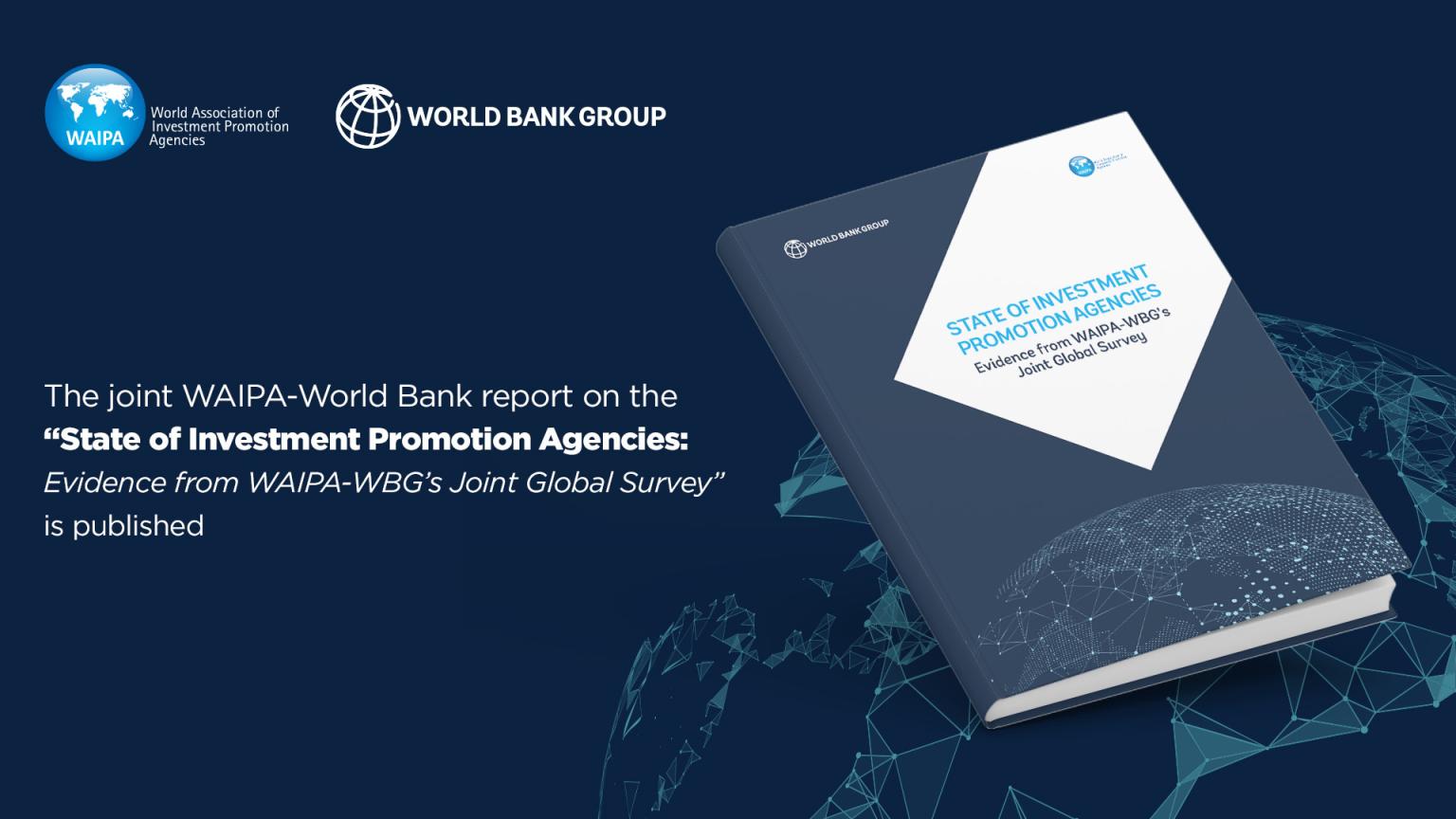With the growing importance of foreign direct investments (FDI) for accelerating development, to eradicate unemployment and increase exports, many governments around the world have established investment promotion agencies (IPAs) to attract, advocate and facilitate investment in their countries. As often being the first entity contacted by investors and serving as an intermediate between foreign investors and the government, they have one of the key roles in the overall site selection, incentives, data collection, bureaucratic certification and company establishment processes. However, knowledge gaps are present regarding their structure and main operations. To fill these gaps, The World Bank Group (WBG) and the World Association of Investment Promotion Agencies (WAIPA) have conducted a comprehensive global survey to capture their main institutional characteristics, corporate planning and services, as well as the main changes and challenges that IPAs are experiencing.
The survey is structured around the novel WBG framework for investment promotion, which includes the following core pillars:
- Corporate planning and sector prioritization: Improving strategic focus via corporate and strategic plan development and improving sector prioritization for investment promotion.
- Institutional framework for FDI: Strengthening the IPA’s institutional framework by improving governance, resources, tools, capacities, and institutional coordination among key stakeholders.
- Investor services: Improving investor-focused services on the basis of the comprehensive investor services framework (CISF), to cover every stage of the investment life cycle (i.e. attraction, entry and establishment, retention and expansion, and linkages and spillovers).
Ninety-one national IPAs from various regions and income groups participated in the survey, where most of the respondents come from high-income countries in Europe and Central Asia.
Corporate Planning and Sector Prioritization
The first pillar emphasizes the importance of IPAs having a written multi-year strategy that clearly maps the necessary steps needed for reaching their main goals and objectives and strategically prioritizing sectors that are most beneficial to the host economy and have future growing prospects. The strategy is a key element of effective investment promotion that should ideally be developed before the establishment of the agency. Survey reveals that 70 percent of IPAs have a multiyear strategy while 24 percent of them do not (6 percent don’t know). Furthermore, Sustainable Development Goals (SDGs) are influencing IPAs’ strategy development and sector targeting. On a 1 to 5 scale, IPAs rated the influence of SDGs on several key areas of their strategies: SDGs have the most influence on the identification of priority sectors and activities (3.78), followed by the establishment of strategic partnerships (3.62), and the evaluation of an IPA’s performance (3.42).
Another important element of investment promotion is sector targeting. Without targeting, an IPA’s attraction efforts are likely to be inefficient and unsuccessful. However, IPAs tend to have many priority sectors: according to the survey findings, an IPA has 11 priority sectors on average. Figure 1 shows that the most popular sectors targeted by IPAs are renewable energy, and information technology (IT) services.
Institutional Framework
It is very important for IPAs to maintain institutional and financial autonomy, as well as degree of flexibility to adjust its internal structure and resources. Agencies with a more business-like structure and clear mandate of investment promotion tend to be more successful in attracting and retaining investments. The survey indicates that IPAs have different organizational structures, reporting lines, and mandates.
What’s more, IPAs have different responsibilities that go beyond of mere investment promotion. An average IPA has eight mandates, where almost all promote foreign investment (97 percent), followed by promotion of domestic investment (67 percent) and policy advocacy (64 percent). Other mandates are shown on Figure 2.
Another important aspect of effective investment promotion is financial flexibility of an IPA. It considerably affects degree of performed activities, quantity and quality of staff, and the existence of overseas and regional offices. Survey findings demonstrate that IPAs vary significantly regarding their financial and human resources. They are mainly financed through governments’ public funds (85 percent), where 34 percent have a budget below US$2 million, while 25 percent have a budget of more than US$10 million. Further analysis of total budget size over different income groups (figure 3) clearly indicates divergence of financial capabilities between IPAs coming from developed and developing countries. The average total budget of agencies from high-income and upper-middle-income countries is US$30.6 million and US$21.4 million, respectively. Subsequently, the average total budget of IPAs from lower-middle-income and low-income countries is considerably lower: US$4.7 million and US$2.4 million, respectively.
When it comes to the distribution of IPAs’ staff, on average an IPA has 161 full-time employees, including 129 technical staff—of which 47 percent are women. On average, 38 staff work solely on investment promotion, while 13 work exclusively on FDI. Of the total number of technical staff working only on investment promotion and FDI, on average 19 (50 percent) and seven (53 percent) are women, respectively.
Investor Services
IPAs, in their primary role as service providers, are best positioned to contribute to meeting government objectives for attracting, establishing, retaining, expanding, and linking productive private investment. Confirming the trend showed in previous WBG research, survey results show that IPAs’ service offering is still too focused at the attraction, and then entry and establishment stage, rather than having a balanced approach across the investment life cycle as desired by investors, experiencing a decay in the retention and expansion and linkages stages (Figure 4).
Challenges and Changes
The COVID-19 crisis is bringing about unprecedented disruptions to the global economy, largely due to the strict policy measures introduced by governments worldwide to suppress the spread of the pandemic. Investment flows across the globe are expected to decrease drastically: UNCTAD estimates that global foreign direct investment (FDI) flows could fall by as much as 40% in 2020. This and the resulting increased competition among countries to attract and retain FDI are the most important challenges that IPAs are facing currently.
The study, conducted before the start of the pandemic, also reveals that other main challenges that IPAs face are related to budgetary issues and financial limitations, the capacity of their staff, and bureaucratic and procedural issues. What’s more, the most common changes anticipated by IPAs in the near future, are the impact of digitalization and technology disruptions, changes in the markets, new investment promotion methods, policy and regulatory changes, and global and trade uncertainty.
IPAs’ Response to the COVID-19
As a result of this new FDI landscape, IPAs have started shifting their focus from FDI attraction to FDI retention by strengthening communication with investors about relevant government measures and bolstering aftercare services such as setting up daily web-based updates on COVID-19 cases and policy responses related to foreign investors (e.g. South Korea, India); proactively identifying and contacting at-risk firms according to number of employees or sector, brokering solutions to their specific issues (e.g. Scotland, South Africa); and advocating for urgent government actions to solve these issues more systematically so that other investors may benefit (e.g. Saudi Arabia, Jordan).
IPAs are also focusing their efforts in addressing the needs of the investors during the COVID-19 crisis, and are undertaking intense efforts in putting together response plans increase resilience by switching to online service delivery (e.g. Ireland, Mauritius) or using social media to communicate closely with investors (e.g. Ethiopia). Finally, some IPAs are facilitating the expansion of companies that receive FDI into new production lines in light of COVID-19 by supporting local suppliers’ business continuity and strategic reorientation to products and services most in demand (e.g. South Africa, Ethiopia).
Conclusion
In order to retain investor confidence in the current scenario of global uncertainty (incl. COVID-19), and leverage FDI as a major source of development financing in the post-pandemic period, IPAs need to think about these three pillars for effective promotion and adapt to the new environment. This would help them understand that they need to shift efforts to investor retention: more than even governments need IPAs to retain investors, save as many jobs as possible and help with a faster recovery.
Despite their heterogeneous characteristics across countries, IPAs are now uniquely positioned to revise their FDI strategies and value propositions toward resilient segments while mitigating their countries’ risk exposure of FDI, as well as their institutional frameworks and service offerings. IPAs which are too focused on events and do not adapt may suffer in a scenario of less government spending and support.
To see all survey’s findings, please download the full report HERE.
Written by
Disclaimer: The views expressed in this article are the author’s own and do not necessarily reflect WAIPA’s stance.




